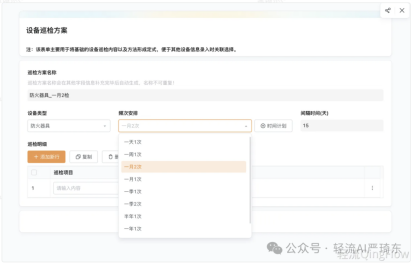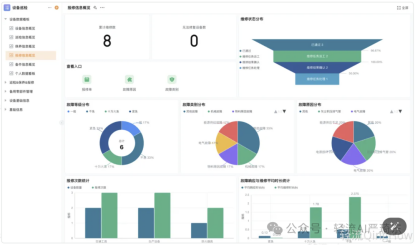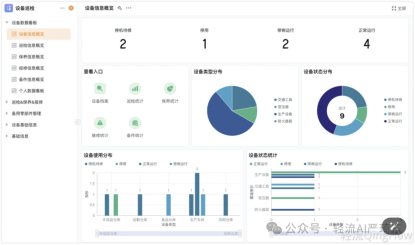A. Overall Description of the Pain Points in Enterprise Equipment Inspection
Enterprise equipment inspection is fraught with numerous challenges that can impede the smooth operation of a business. These pain points not only affect the efficiency of equipment maintenance but also have a direct impact on the bottom line.
- High cost: Paper - based inspection methods incur expenses related to printing, storage, and distribution. Additionally, the need for manual labor to conduct inspections and record data adds to the overall cost.
- Inefficient data collection: Manual data entry is time - consuming and prone to errors. Inspectors may forget to record important information, or data may be entered incorrectly, leading to inaccurate reports.
- Lack of real - time monitoring: Traditional inspection methods often rely on periodic checks, which means that potential issues may go undetected until it's too late. Without real - time data, it's difficult to make timely decisions and take preventive actions.
- Poor communication and collaboration: In a large enterprise, different departments may be involved in equipment inspection. However, there may be a lack of effective communication channels, resulting in delays in information sharing and problem - solving.
In summary, these pain points in enterprise equipment inspection can lead to increased costs, reduced productivity, and potential equipment failures, which pose a significant threat to the normal operation of the enterprise.
B. Case Analysis of the Pain Points in Enterprise Equipment Inspection
1. High cost
In a manufacturing enterprise, the use of paper - based inspection forms is a common practice. For example, in a factory that produces automotive parts, inspectors need to fill out paper forms for each piece of equipment they inspect. These forms need to be printed regularly, and the cost of paper, ink, and printing equipment can be substantial. Moreover, storing these paper forms requires a large amount of physical space, and retrieving specific forms when needed can be a time - consuming process.
For instance, Tesaia (Ningbo) Mechanical Manufacturing Co., Ltd. used to rely on paper - based documents for equipment inspection. The customization, printing, and mailing of these documents consumed a significant amount of time and money. This additional cost put pressure on the company's budget and affected its overall profitability.
2. Inefficient data collection
Manual data collection in equipment inspection is often error - prone. In a chemical plant, inspectors are required to record various parameters of the equipment, such as temperature, pressure, and flow rate. However, due to human error, they may misread the instruments or record the data incorrectly. This inaccurate data can lead to wrong decisions regarding equipment maintenance and operation.
Take the example of a power plant. Inspectors used to record data manually during equipment inspections. There were cases where important data was omitted or recorded inaccurately, which made it difficult for the management to assess the actual condition of the equipment. As a result, some potential equipment failures were not detected in time, leading to unexpected shutdowns and production losses.
3. Lack of real - time monitoring
In a construction site, heavy machinery such as cranes and excavators are in constant use. Without real - time monitoring, it's difficult to detect potential problems with these machines. For example, if a crane's hydraulic system is malfunctioning, it may not be noticed until a serious accident occurs.
In the case of a smart building, the building management system needs to monitor the operation of various equipment, such as elevators, air - conditioning systems, and lighting. If there is no real - time monitoring, a minor issue with an elevator may escalate into a major breakdown, causing inconvenience to the building occupants and potential safety risks.
4. Poor communication and collaboration
In a large enterprise with multiple departments involved in equipment inspection, communication breakdowns can occur. For example, in an electronics manufacturing company, the production department may notice a problem with a piece of equipment during operation, but they may not be able to communicate this information effectively to the maintenance department.
In Tesaia (Ningbo), the communication between different departments was a major issue. When equipment needed to be repaired, the information was often not conveyed accurately or in a timely manner. This led to the maintenance workers having to make multiple trips to the site to gather information and apply for spare parts, which significantly delayed the repair process.
C. Product Introduction for Solving Equipment Inspection Pain Points
1. Traditional Inspection Software
Traditional inspection software can help automate some aspects of the equipment inspection process. It allows inspectors to record data electronically, which reduces the risk of errors associated with manual data entry. However, most traditional software is highly customized and requires significant IT resources for implementation and maintenance. It may also lack real - time data processing capabilities and seamless integration with other enterprise systems.
2. IoT - enabled Inspection Devices
IoT - enabled inspection devices can collect real - time data from equipment. These devices are equipped with sensors that can monitor various parameters such as temperature, vibration, and pressure. The data collected can be transmitted wirelessly to a central server for analysis. However, the installation and management of these devices can be complex, and there may be issues related to data security and compatibility.
3. No - code Platform: Wingent
Wingent is a no - code development platform that offers a comprehensive solution for enterprise equipment inspection. It can be easily customized to meet the specific needs of different enterprises without the need for extensive coding knowledge. With Wingent, you can quickly build applications for equipment inspection, data collection, and real - time monitoring.
D. How Wingent Solves the Pain Points in Enterprise Equipment Inspection
Wingent's Powerful Features for Equipment Inspection
Wingent is a game - changer in the field of enterprise equipment inspection. It offers a wide range of features that can effectively address the pain points mentioned above.
1. Standardized Inspection
Wingent allows enterprises to customize standardized inspection templates according to their equipment characteristics and management requirements using a professional form design tool. For example, a power company can design an inspection template for its transformers, including parameters such as temperature, voltage, and oil level.

In the template, rich conditional branch logic can be set. When the equipment parameters exceed the normal range, the system automatically triggers the repair process, realizing intelligent inspection. A certain power enterprise adopted this standardized inspection mode, and the equipment miss - inspection rate was reduced by 70%. This shows that Wingent can significantly improve the accuracy and efficiency of equipment inspection, ensuring that each piece of equipment is inspected in a timely and comprehensive manner.
2. Real - time Monitoring and Data Visualization
Wingent integrates IoT technology and data dashboards to achieve real - time monitoring of equipment. Through relevant technical means, key operating parameters of the equipment, such as temperature, pressure, and vibration, can be collected in real - time and transmitted to the data dashboard.

At the same time, digital twin technology is used to construct a virtual model that corresponds precisely to the physical equipment, intuitively presenting the operating status of the equipment. When the temperature of a certain equipment component rises abnormally, the corresponding component of the virtual model will change color prominently to give an early warning, enabling managers to quickly detect potential problems and take preventive measures in advance. This real - time monitoring function can effectively avoid production interruptions caused by equipment failures, ensuring the stable and continuous operation of production.
3. Predictive Maintenance
Based on the long - term historical data of the equipment, combined with advanced AI algorithms, Wingent can conduct in - depth analysis of the equipment operation mode and accurately predict possible failures. When the equipment operation data shows an abnormal trend, the system automatically generates a maintenance work order and intelligently recommends the required spare parts based on the prediction results.

For example, a chemical enterprise applied this predictive maintenance technology, and the equipment failure downtime was shortened by 50%. In the past, sudden equipment failures caused huge losses to production. Now, through predictive maintenance, enterprises can plan maintenance work in advance and prepare spare parts, effectively reducing the impact of equipment failures on production.
4. Mobile - based Inspection
Wingent provides a convenient mobile application for equipment inspection. Inspectors can use their mobile devices to scan the QR code of the equipment for inspection. The equipment positioning and photo watermark anti - tampering technology ensure the authenticity and reliability of the inspection data.

Once the equipment operating parameters are abnormal, the system automatically triggers a maintenance work order and accurately pushes it to the responsible person. An electronic manufacturing enterprise used mobile - based inspection, and the time to discover equipment abnormalities was significantly reduced from an average of 2 hours to within 15 minutes, greatly improving the timeliness of equipment maintenance and effectively ensuring the smooth progress of production.
5. Cost Control
Wingent's intelligent spare parts management system uses big data analysis technology to analyze the equipment maintenance historical data and inventory data in real - time. Based on the equipment failure probability and spare parts consumption law, it can accurately predict the spare parts inventory demand.

By reasonably controlling the spare parts inventory level, enterprises can effectively reduce the phenomenon of spare parts overstocking and waste. A mechanical manufacturing enterprise applied this system and saved hundreds of thousands of yuan in annual warehousing costs. In the past, enterprises stocked a large number of spare parts to deal with sudden equipment failures, resulting in serious inventory overstocking and a large amount of capital occupation. Now, through accurate inventory prediction, enterprises can minimize inventory costs while ensuring equipment maintenance needs, improving the efficiency of capital use.
6. Quality Traceability
Wingent records all data in the equipment management process, providing strong support for enterprise quality traceability. From equipment procurement to operation and subsequent maintenance, all relevant data is completely recorded. When a product quality problem occurs, the enterprise can generate a traceability report with one click through the system to quickly locate the source of the problem.
For example, a dyeing and finishing factory used this function, and the efficiency of problem - locating was improved by 50%. In the past, enterprises needed to spend a lot of time and manpower to investigate the production process when facing quality problems. Now, with the help of digital quality traceability, enterprises can quickly find information related to equipment operation and maintenance associated with quality problems and take timely improvement measures to improve product quality.
In summary, Wingent comprehensively addresses the pain points in enterprise equipment inspection through its diverse and powerful functions. It streamlines the inspection process, improves data accuracy, enables real - time monitoring and predictive maintenance, and effectively controls costs and ensures quality traceability. By using Wingent, enterprises can achieve a more efficient, intelligent, and reliable equipment inspection and management system.
In conclusion, enterprise equipment inspection is a critical aspect of business operations, and the pain points in this area can have a significant impact on an enterprise's efficiency, cost, and productivity. Through the analysis of the pain points and the introduction of relevant products, especially Wingent, we have seen that modern technology can provide effective solutions. Wingent, with its standardized inspection, real - time monitoring, predictive maintenance, mobile - based inspection, cost control, and quality traceability features, can help enterprises overcome these pain points and achieve a more efficient and intelligent equipment inspection process.
Reference
[1]生产设备管理:一全、二实、三预、四驱、五联 https://mp.weixin.qq.com/s/slh_SRaDdwl07yYTLHcPUg [2]3000字把怎么做设备档案、巡检、报修、保养讲清楚了 https://mp.weixin.qq.com/s/uxhoGdjN9JrN3XGpw6XDMA